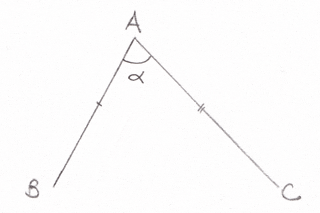The Thirteen Books of the Elements
Euclid
Book I
Book I
Reference edition: Sir Thomas Heath, Johan Ludvig Heiberg
The University Press, 1908
The University Press, 1908
Proposition I: Given finite straight line AB, to construct an equilateral triangle.
Proposition II: To place at a given point a straight line equal to a given straight line.
Given point A and straight line BC,
Construct equilateral triangle ΔABD [Prop. I]
Construct the circle with center B, and radius BC.
Extend the straight line DB to intersect the circle. Call the point of intersection F
BC ≅ BF
BC ≅ BF
Construct the circle with center D and radius DF.
Extend straight line DA to intersect this new circle. Call the point of intersection G:
Now, DG ≅ DF
and AD ≅ BDAnd therefore DG − AD ≅ DF − BD
But DG − AD = AG
and DF − BD = BF
Hence AG ≅ BF.
Proposition III: Given two unequal straight lines, to cut off from the greater a straight line equal to the lesser.
Given straight line AB (the greater) and straight line C (the lesser),
Extend the side of the triangle to the circle. (Prop II)
Draw a second circle with center at D and extend DA to intersect the circle. (Prop II)
Draw a third circle with center A which also intersects this point:The intersection of this last circle with AB is labeled γ.
Aγ ≅ C and the construction is complete.
Proposition IV: Side-Angle-Side Congruence
If you can find more than one way to draw the segment BC, let me know.
Proposition V: In an isosceles triangle, the base angles are equal. If the equal sides are extended in straight lines, the angles under the base are equal.
Given AB
Construct AC = AB and isosceles triangle ΔABC.
Construct AC = AB and isosceles triangle ΔABC.Extend AB to arbitrary point F.
Place CG = BF [Prop II, or by definition with the compass]
Connect FC, GB
ΔFCA ≅ ΔGBA [Prop IV, common angle ∠A]
The corresponding angles and sides are then equal, namely
FC = GB, ∠CFA ≅ ∠BGA
Then ΔFCB ≅ ΔGBC and
∠FBC = ∠GCB, (the angles under the base)
∠BCF = ∠CBG
And ∠ABC = ∠ABG −∠CBG = ∠ACF − ∠BCF = ∠ACB (the base angles of the isosceles triangle)
Which were the things to be proved.
{Next −−>}
____________________________________There are hundreds of propositions remaining of which I will post a selection, including only a restatement of the Proposition and a completed diagram.













No comments:
Post a Comment